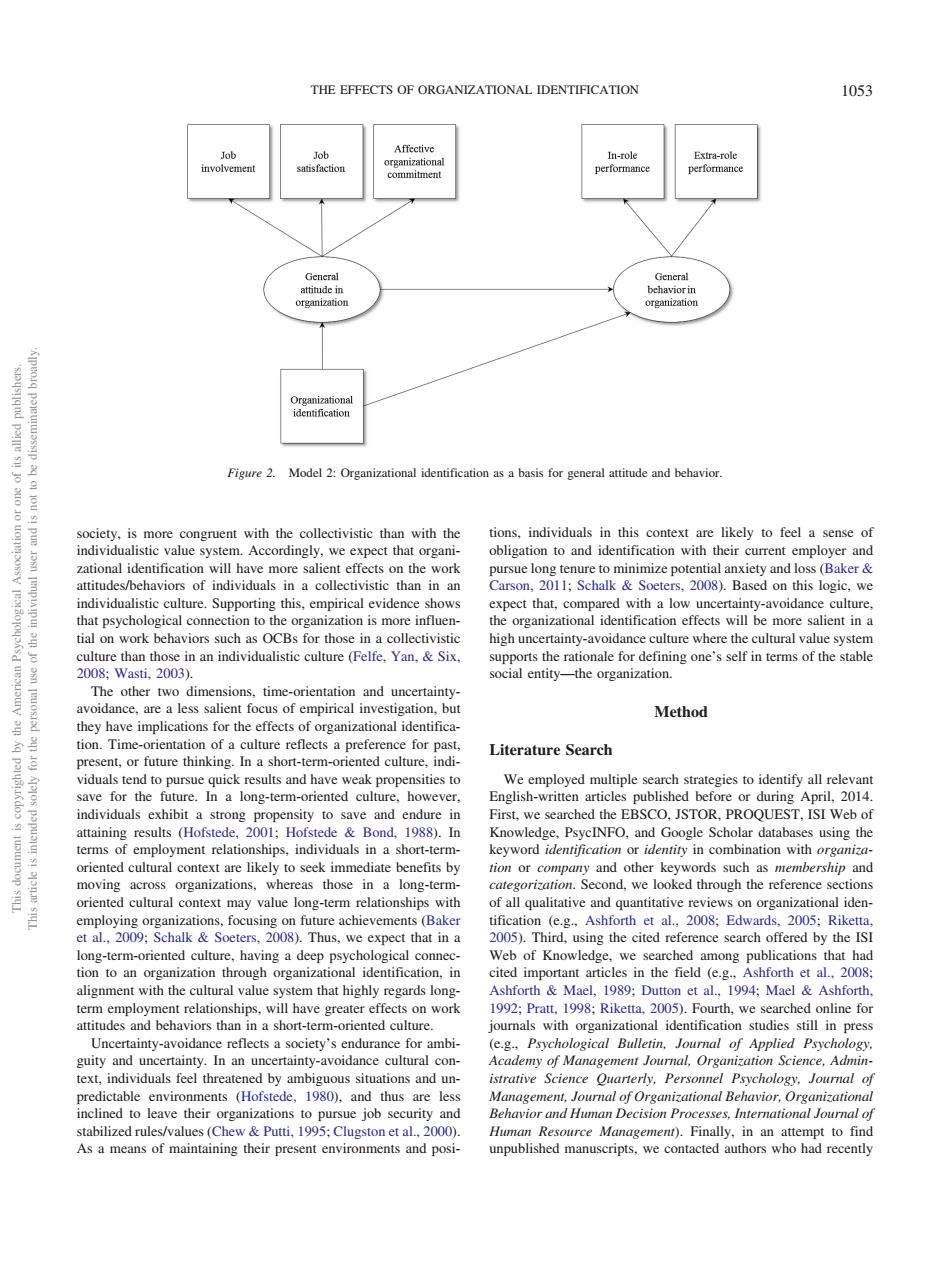正在加载图片...

THE EFFECTS OF ORGANIZATIONAL IDENTIFICATION 1053 Figure2.Model 2:Organizational idenificationsa basis for general attitude and behavio Zationalidcnti6 ect that c ared wit a low uncer int -avoidance cultur hat psy loecelconnectionoteoregamizationismorennc thos in an individualistic culture (Felfe.Yan.&Six. orts the rationale for defining of the stable 200 entity-the organization time-orientation Method It. Literature Search ent.or n uture thinking.In a short-term-oriented cultu we sarched the EBSCO.JSTOR.PROQUEST.ISI Webof d identification or identiry in combination with organia ntext may value long-term relation hi witl ll qualitative and quantitative reviev ider ct that in mong publications hat had lignment with the cultural value em that highly regards i 1989:Dutton et al 1994:Macl Ashfonh 992 19y98 Uncertainty-avoidand e reflects a society's enduran for amb c.g. ological Bulletin. Appl n an un Or D table enviror nents (Hofstede,1980).and thus are les vior.Or to find As a means of maintaining their present environments and posisociety, is more congruent with the collectivistic than with the individualistic value system. Accordingly, we expect that organizational identification will have more salient effects on the work attitudes/behaviors of individuals in a collectivistic than in an individualistic culture. Supporting this, empirical evidence shows that psychological connection to the organization is more influential on work behaviors such as OCBs for those in a collectivistic culture than those in an individualistic culture (Felfe, Yan, & Six, 2008; Wasti, 2003). The other two dimensions, time-orientation and uncertaintyavoidance, are a less salient focus of empirical investigation, but they have implications for the effects of organizational identification. Time-orientation of a culture reflects a preference for past, present, or future thinking. In a short-term-oriented culture, individuals tend to pursue quick results and have weak propensities to save for the future. In a long-term-oriented culture, however, individuals exhibit a strong propensity to save and endure in attaining results (Hofstede, 2001; Hofstede & Bond, 1988). In terms of employment relationships, individuals in a short-termoriented cultural context are likely to seek immediate benefits by moving across organizations, whereas those in a long-termoriented cultural context may value long-term relationships with employing organizations, focusing on future achievements (Baker et al., 2009; Schalk & Soeters, 2008). Thus, we expect that in a long-term-oriented culture, having a deep psychological connection to an organization through organizational identification, in alignment with the cultural value system that highly regards longterm employment relationships, will have greater effects on work attitudes and behaviors than in a short-term-oriented culture. Uncertainty-avoidance reflects a society’s endurance for ambiguity and uncertainty. In an uncertainty-avoidance cultural context, individuals feel threatened by ambiguous situations and unpredictable environments (Hofstede, 1980), and thus are less inclined to leave their organizations to pursue job security and stabilized rules/values (Chew & Putti, 1995; Clugston et al., 2000). As a means of maintaining their present environments and positions, individuals in this context are likely to feel a sense of obligation to and identification with their current employer and pursue long tenure to minimize potential anxiety and loss (Baker & Carson, 2011; Schalk & Soeters, 2008). Based on this logic, we expect that, compared with a low uncertainty-avoidance culture, the organizational identification effects will be more salient in a high uncertainty-avoidance culture where the cultural value system supports the rationale for defining one’s self in terms of the stable social entity—the organization. Method Literature Search We employed multiple search strategies to identify all relevant English-written articles published before or during April, 2014. First, we searched the EBSCO, JSTOR, PROQUEST, ISI Web of Knowledge, PsycINFO, and Google Scholar databases using the keyword identification or identity in combination with organization or company and other keywords such as membership and categorization. Second, we looked through the reference sections of all qualitative and quantitative reviews on organizational identification (e.g., Ashforth et al., 2008; Edwards, 2005; Riketta, 2005). Third, using the cited reference search offered by the ISI Web of Knowledge, we searched among publications that had cited important articles in the field (e.g., Ashforth et al., 2008; Ashforth & Mael, 1989; Dutton et al., 1994; Mael & Ashforth, 1992; Pratt, 1998; Riketta, 2005). Fourth, we searched online for journals with organizational identification studies still in press (e.g., Psychological Bulletin, Journal of Applied Psychology, Academy of Management Journal, Organization Science, Administrative Science Quarterly, Personnel Psychology, Journal of Management, Journal of Organizational Behavior, Organizational Behavior and Human Decision Processes, International Journal of Human Resource Management). Finally, in an attempt to find unpublished manuscripts, we contacted authors who had recently Figure 2. Model 2: Organizational identification as a basis for general attitude and behavior. This document is copyrighted by the American Psychological Association or one of its allied publishers. This article is intended solely for the personal use of the individual user and is not to be disseminated broadly. THE EFFECTS OF ORGANIZATIONAL IDENTIFICATION 1053